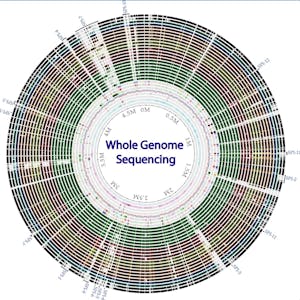This course will cover the topic of Whole genome sequencing (WGS) of bacterial genomes which is becoming more and more relevant for the medical sector. WGS technology and applications are high on international political agenda, as the classical methods are being replaced by WGS technology and therefore bioinformatic tools are extremely important for allowing the people working in this sector to be able to analyze the data and obtain results that can be interpreted and used for different purposes. The course will give the learners a basis to understand and be acquainted with WGS applications in surveillance of bacteria including species identification, typing and characterization of antimicrobial resistance and virulence traits as well as plasmid characterization. It will also give the opportunity to learners to learn about online tools and what they can be used for through demonstrations on how to use some of these tools and exercises to be solved by learners with use of freely available WGS analysis tools .By the end of this course you should be able to:
- Describe the general Principles in typing of Bacteria
- Give examples of the applications of Whole Genome Sequencing to Surveillance of bacterial pathogens and antimicrobial resistance
- Apply genomic tools for sub-typing and surveillance
- Define the concept of Next-Generation Sequencing and describe the sequencing data from NGS
- Describe how to do de novo assembly from raw reads to contigs
- Enumerate the methods behind the tools for species identification, MLST typing and resistance gene detection
- Apply the tools for species identification, MLST typing and resistance gene detection in real cases of other bacterial and pathogen genomes.
- Describe the methods behind the tools for Salmonella and E.coli typing, plasmid replicon detection and plasmid typing
- Utilize the tools for Salmonella and E.coli typing, plasmid replicon detection and plasmid typing in real cases of other bacterial and pathogen genomes.
- Explain the concept and be able to use the integrated bacterial analysis pipeline for batch analysis and typing of genomic data
- Demonstrate how to construct phylogenetic tree based on SNPs
- Apply the phylogenetic tool to construct phylogenetic trees and explain the relatedness of bacterial or pathogen strains
- Describe how to create your own sequence database
- Utilize the MyDbFinder tool to detect genetic markers of interest from whole genome sequencing
None
Syllabus
Syllabus - What you will learn from this course
Week 1
Module 1
Welcome and introduction to typing of bacteria and use of Whole genome sequencing applied to surveillance of bacterial pathogens and antimicrobial resistance
Week 2
Module 2
Introduction to Next Generation sequencing
Week 3
Module 3
Whole genome sequencing tools- demonstration of analysis tools for species identification, MLST typing and finding resistance genes
Week 4
Module 4
Whole genome sequencing tools- demonstration of analysis tools for Serotyping of Salmonella and Escherichia coli strains , and finding plasmid replicons
Week 5
Module 5
Whole genome sequencing tools- demonstration of analysis tools for multiple analyzes, phylogenetic tree building and finding genetic markers from self-made databases and Summative Tutorial exercise
FAQ
When will I have access to the lectures and assignments?
Access to lectures and assignments depends on your type of enrollment. If you take a course in audit mode, you will be able to see most course materials for free. To access graded assignments and to earn a Certificate, you will need to purchase the Certificate experience, during or after your audit. If you don't see the audit option:
What will I get if I purchase the Certificate?
When you purchase a Certificate you get access to all course materials, including graded assignments. Upon completing the course, your electronic Certificate will be added to your Accomplishments page - from there, you can print your Certificate or add it to your LinkedIn profile. If you only want to read and view the course content, you can audit the course for free.
Is financial aid available?
Yes. In select learning programs, you can apply for financial aid or a scholarship if you can’t afford the enrollment fee. If fin aid or scholarship is available for your learning program selection, you’ll find a link to apply on the description page.
Reviews
The instructors are very efficient and helped me learn with full understanding and made me proficient to use the tools and databases.
Thank you very much ;)
Excellent Course. Many thanks to DTU and Coursera for providing such a wonderful course. I learned a lot of things from this course. This course is definitely a winner.
Thank you very much for this course through which i learnt basic handling of bioinformatics tools and concepts of WGS. This will help me a lot while pursuing my PhD research work in my field.
My knowledge of Whole Genome Sequencing has been basically from theory classes, but this course offered the opportunity to interpret some results practically.
